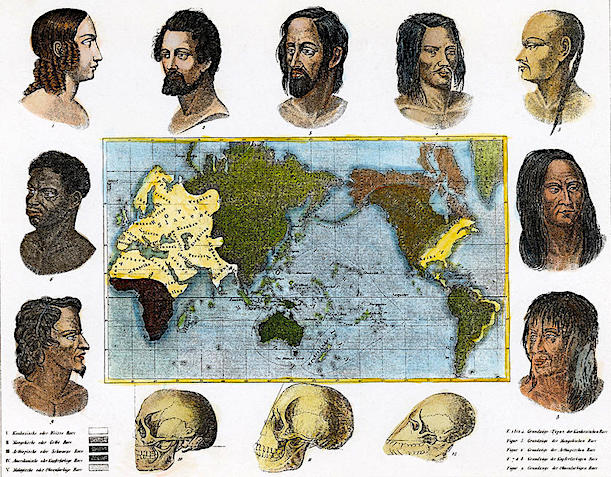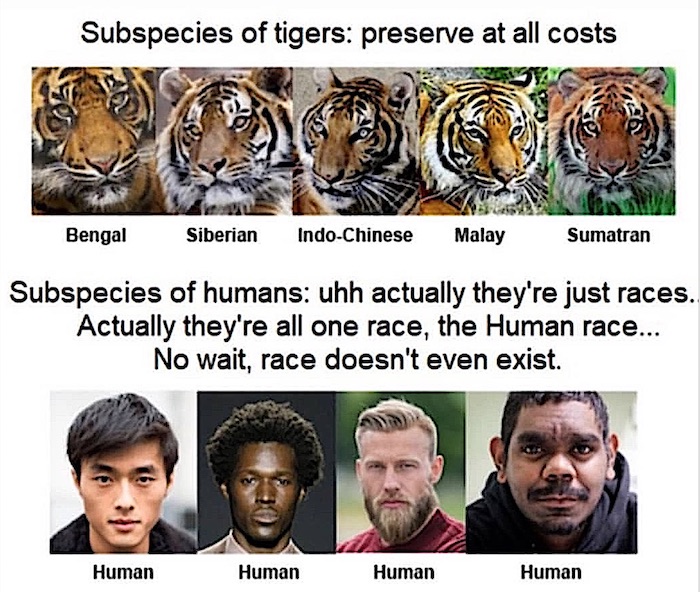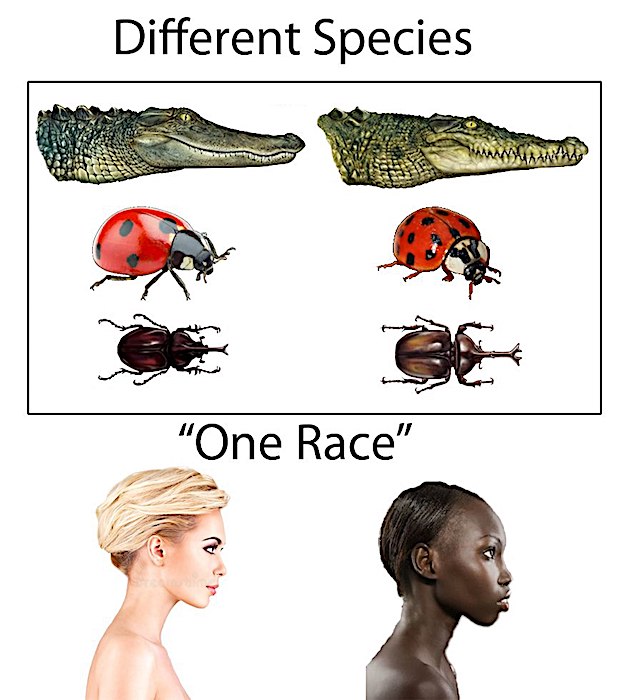
(The Proceedings of the National Academy of Sciences) A new 2023 study entitled “All human social groups are human, but some are more human than others: A comprehensive investigation of the implicit association of ‘Human’ to US racial/ethnic groups” concludes that while all peoples are “human”, a certain group of Whites more strongly identifies as human than other non-White groups:
“All humans belong to the species Homo sapiens. Yet, throughout history, humans have breathed life into the Orwellian adage that “All [humans] are equal, but some [humans] are more equal than others.”
Here, participants staunchly rejected this adage, with the overwhelming majority of over 61,000 participants reporting that all humans are equally human. However, across 13 experiments, US White participants (and White participants abroad) showed robust evidence of an implicit Human=Own Group association. Conversely, Black, Latinx, and Asian participants in the United States did not demonstrate this bias.
These results highlight the tendency among socially dominant groups to reserve the quality Human for their own kind, producing, even in the 21st century, the age-old error of pseudospeciation.
Abstract
All human groups are equally human, but are they automatically represented as such? Harnessing data from 61,377 participants across 13 experiments (six primary and seven supplemental), a sharp dissociation between implicit and explicit measures emerged.Despite explicitly affirming the equal humanity of all racial/ethnic groups, White participants consistently associated Human (relative to Animal) more with White than Black, Hispanic, and Asian groups on Implicit Association Tests (IATs; experiments 1–4).
This effect emerged across diverse representations of Animal that varied in valence (pets, farm animals, wild animals, and vermin; experiments 1–2). Non-White participants showed no such Human=Own Group bias (e.g., Black participants on a White–Black/Human–Animal IAT).
However, when the test included two outgroups (e.g., Asian participants on a White–Black/Human–Animal IAT), non-White participants displayed Human=White associations.
The overall effect was largely invariant across demographic variations in age, religion, and education but did vary by political ideology and gender, with self-identified conservatives and men displaying stronger Human=White associations (experiment 3).
Using a variance decomposition method, experiment 4 showed that the Human=White effect cannot be attributed to valence alone; the semantic meaning of Human and Animal accounted for a unique proportion of variance. Similarly, the effect persisted even when Human was contrasted with positive attributes (e.g., God, Gods, and Dessert; experiment 5a).
Experiments 5a-b clarified the primacy of Human=White rather than Animal=Black associations. Together, these experiments document a factually erroneous but robust Human=Own Group implicit stereotype among US White participants (and globally), with suggestive evidence of its presence in other socially dominant groups.”
What this study appears to suggest is that while many White people may give lip service to the notion that all peoples are “human”, their lived experience and understanding of world history contradicts that social conditioning and political indoctrination.
And since all respondents in this study have been socially conditioned to concede that all peoples are “human” for fear of being stigmatized as “racist,” they appear to unconsciously try to disagree with that premise in a roundabout, socially acceptable fashion.
The term “human” has been erroneously conflated with the “scientific” term “homo sapiens” — Swedish taxonomist, Carl Linnaeus, coined the term “homo sapiens” in 1735 many centuries after a variant of the term “human” was derived from the Latin “humanus” which means:
“…of man, human,” also “humane, philanthropic, kind, gentle, polite; learned, refined, civilized.”
As we can see from this definition, the term “human” could hardly encompass all people grouped under the later term “homo sapiens” — in fact, it best describes those who built and occupied the Greco-Roman “world” — who coined the term “humanus” to describe themselves, not all hominoid peoples.
And when Carl Linnaeus defined the term “homo sapiens,” it was met with public outcry because he had classified humans generically as part of the animal kingdom — and worse, arbitrarily grouped them as a kind of ape — merely based on physiological similarities.
In response to this criticism, Linnaeus would eventually introduce four sub-varieties of “homo sapiens” — with the “Europeanus” variety which demonstrated the highest culture, which he erroneously attributed to environment rather than biology — as the field of genetics had yet to be discovered.
This idea that cultural differences can lead to divergence in species or kinds is called “pseudospeciation” — and even Christians have engaged in this fallacy when they attempt to account for the vastly different human groups by claiming that language differences in Babel and separation caused the readily perceived racial characteristics in the races.
These early practitioners of the fledgling field of Taxonomy were largely White Christian men who mistakenly believed that all of those who fell under the category of “homo sapiens” must somehow be descendants of Adam from the Bible — such as the Anglo-Irish naturalist, Robert Boyle.
However, the Scottish philosopher, Henry Homes, Lord Kames (1695-1782) took the most reasonable approach to this conundrum by asserting,
“…God had created different races on Earth in separate regions. In his 1734 book ‘Sketches on the History of Man,’ Home claimed that the environment, climate, or state of society could not account for racial differences, so the races must have come from distinct, separate stocks.”
The English word “man” derives from the Germanic term “mann,” which likely derived from the name of the pre-Christian, Germanic pagan god, Mannus, the progenitor of the Germanic tribes, as described by the Roman historian Tacitus in his work, Germania.
And for these Germanic tribes a “mann” was not a universalist term — it specifically related only to their own or related tribes — and only later did the term “man” become universal — most likely because of the false dictates of Christian universalist doctrines.
However, during the Christian Era, “man” originally referred to a member of the Adamic creation — or Adamkind — from the Book of Genesis in the Bible — and the Hebrew word “Adam” was translated as “man” in English — both terms deriving from similar unique and divine creation accounts.
The specific tribes who were the legitimate descendants of Adam are identified in the Bible as the Genesis 10 nations — and it is impossible to trace all known races back to those tribes.
Charles Darwin would pick up on the work of Carl Linnaeus — by positing the spurious idea that lower life forms “evolved” spontaneously into higher life forms — most controversially that man evolved from apes — thus “scientifically” showing that all “homo sapiens” have a common ape-like ancestor — legitimizing the concept of “racial universalism”.
But many scientists and natural philosophers refused to accept this universalist “human” notion — and set about to prove that not only were racial differences real — but that they accounted for the vast disparity in cultural and civilizational development among the different races.
Those who studied hierarchical race differences were smeared for advocating for “scientific racism” — but it persisted as a legitimate field of inquiry until the end of World War II when the bogus accusations of the Holocaust™ were laid at the feet of the vanquished Germans who were staunch advocates of these racial ideas.
After World War II, Jews began to dominate all academic disciples, especially anthropology — and anyone who even believed that race was anything but a “social construct” — or challenged the unscientific theory of evolution — had no chance to get a job in academia — after all, that kind of thinking was “pseudo-scientific” and will inevitably lead to “another” Holocaust™.
Thus, the original concept of a “human” — referring specifically to Western Man — has become politicized — to the point that small differences in animals are accepted as evidence of separate species whereas in humans even more radical differences are ignored in order to maintain the idea of a universal “human” race.
As this above-mentioned study shows, non-Whites naturally do not strongly identify as “human” simply because it is a concept alien to them because it was conceived by White people to describe their own race — and beneath all the brainwashing and social stigmas, Whites intuitively understand to whom “human” refers — and to whom it does not.




And below are the people who think they can “pass” as White while telling us that race doesn’t exist — it’s all in your head, goyim:


 RSS Feed
RSS Feed















 June 3rd, 2023
June 3rd, 2023  Awake Goy
Awake Goy  Posted in
Posted in  Tags:
Tags: 













